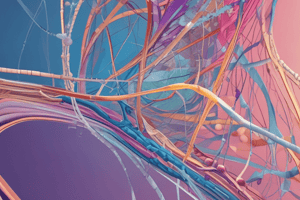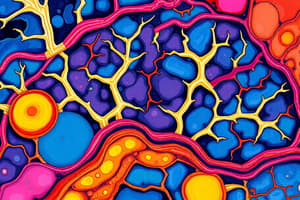Podcast
Questions and Answers
The extracellular matrix is commonly associated with connective tissue like bone, ligaments, tendons, and ______.
The extracellular matrix is commonly associated with connective tissue like bone, ligaments, tendons, and ______.
cartilage
Procollagen is a precursor of collagen that is secreted from ______.
Procollagen is a precursor of collagen that is secreted from ______.
cells
The hydrogen bond between OH groups of proline and ______ stabilizes molecules in collagen fibers.
The hydrogen bond between OH groups of proline and ______ stabilizes molecules in collagen fibers.
lysine
Elastin provides greater ______ than tensile strength in specific tissues such as arteries and lungs.
Elastin provides greater ______ than tensile strength in specific tissues such as arteries and lungs.
Elastins differ from collagen as they do not contain hydroxylated forms of ______.
Elastins differ from collagen as they do not contain hydroxylated forms of ______.
Protein receptors in the extracellular matrix are located on the surface of the ______.
Protein receptors in the extracellular matrix are located on the surface of the ______.
When a substance in the extracellular matrix combines with a receptor, it alters the structural form and initiates a ______ signal.
When a substance in the extracellular matrix combines with a receptor, it alters the structural form and initiates a ______ signal.
The altered activity of the nucleus can affect the transcription of ______.
The altered activity of the nucleus can affect the transcription of ______.
Fibronectins are the most common adhesive ______ that belong to the family of glycoproteins.
Fibronectins are the most common adhesive ______ that belong to the family of glycoproteins.
De novo synthesis denotes to the synthesis of large molecules from ______ molecules such as polysaccharides from monosaccharides.
De novo synthesis denotes to the synthesis of large molecules from ______ molecules such as polysaccharides from monosaccharides.
Laminins are adhesive ______ found in the basal lamina of the extracellular matrix.
Laminins are adhesive ______ found in the basal lamina of the extracellular matrix.
The glycocalyx is a CHO molecules rich zone outside of the ______ membrane.
The glycocalyx is a CHO molecules rich zone outside of the ______ membrane.
Cadherins are calcium-dependent adhesion ______ that function in cell adhesion.
Cadherins are calcium-dependent adhesion ______ that function in cell adhesion.
Plasmodesmata are conduits between the cell walls of two adjacent ______ cells.
Plasmodesmata are conduits between the cell walls of two adjacent ______ cells.
Fibronectins consist of two polypeptide chains joined by ______ bonds.
Fibronectins consist of two polypeptide chains joined by ______ bonds.
The glycocalyx is also referred to as the ______ matrix of the cell membrane.
The glycocalyx is also referred to as the ______ matrix of the cell membrane.
The three types of macromolecules found in the ECM of animal cells are structural proteins, ______, and adhesive glycoproteins.
The three types of macromolecules found in the ECM of animal cells are structural proteins, ______, and adhesive glycoproteins.
The extracellular matrix helps attach cells to the matrix through ______ like laminins and fibronectins.
The extracellular matrix helps attach cells to the matrix through ______ like laminins and fibronectins.
The process by which cells can migrate and develop is influenced by the ______ of the extracellular matrix.
The process by which cells can migrate and develop is influenced by the ______ of the extracellular matrix.
Glycosaminoglycans attract water due to their ______ charges, aiding in the formation of gel-like structures.
Glycosaminoglycans attract water due to their ______ charges, aiding in the formation of gel-like structures.
The core proteins of proteoglycans can range from ______ to 500,000 molecular weight.
The core proteins of proteoglycans can range from ______ to 500,000 molecular weight.
Collagens and elastins are examples of ______ found in the extracellular matrix.
Collagens and elastins are examples of ______ found in the extracellular matrix.
The ______ is made up of fibrous proteins, polysaccharides, glycoproteins, and amorphous matrix.
The ______ is made up of fibrous proteins, polysaccharides, glycoproteins, and amorphous matrix.
Extracellular structures like the cell wall and cell membrane originate from the ______ of the cell.
Extracellular structures like the cell wall and cell membrane originate from the ______ of the cell.
Flashcards are hidden until you start studying
Study Notes
Extracellular Matrix (ECM) Overview
- ECM is primarily linked to connective tissues, including bone, ligaments, tendons, and cartilage.
- Procollagen is the precursor to collagen, synthesized and secreted by cells before being cleaved by collagen peptidase to form collagen molecules.
- Collagen molecules aggregate to create fibrils, which further combine to form fibers.
- Stability of collagen fibers is enhanced by hydrogen bonds between hydroxyl groups of proline and lysine.
Types of Collagen
- Numerous types of collagen exist, determined by genetic coding of different α chains.
Structure and Function of Elastin
- Elastin provides elasticity, notably in arteries, lungs, and intestines, emphasizing flexibility over tensile strength.
- Structurally distinct from collagen, elastin includes glycine and proline, lacks hydroxylated forms, and has single molecules linked by lysine covalent bonds.
Protein Receptors in ECM
- ECM serves as a site for protein receptors that interact with substances, altering receptor structure and triggering intracellular signaling.
- This interaction can influence nuclear activity, affecting processes like DNA transcription.
Fibronectins
- Fibronectins are prevalent adhesive glycoproteins, existing in soluble, insoluble, or intermediate states.
- All fibronectins are derived from a single gene, with variations arising from RNA processing.
- Each fibronectin consists of two polypeptide chains linked by disulfide bonds and exhibits different structural domains.
De Novo Synthesis
- Refers to building large molecules from basic components, such as synthesizing polysaccharides from monosaccharides and proteins from amino acids.
Laminins
- Laminins are adhesive proteoglycans situated in the basal lamina of the ECM, separating epithelial cells from connective tissue.
Glycocalyx
- Glycocalyx refers to a carbohydrate-rich zone outside animal cell plasma membranes, vital for cell adhesion, recognition, protection, and permeability.
- Composed of glycoproteins and glycolipids, it encases the cell membrane.
Cadherins
- Cadherins are calcium-dependent adhesion molecules crucial for forming adherens junctions and connecting neighboring cells.
Plasmodesmata
- Plasmodesmata are channels between adjacent plant cell walls, facilitating material exchange between cells.
- These structures are essential during tissue development and migration of cells.
Proteoglycans
- Proteoglycans modulate the function of signaling molecules, binding growth factors to influence cell signaling.
- Composed of glycosaminoglycans linked to proteins, they attract water, aiding in creating a gel-like matrix.
ECM Composition and Functionality
- Extracellular structures include cell walls, membranes, and ECM, derived from cellular secretions of proteins, polysaccharides, and glycoproteins.
- Key macromolecules in ECM comprise structural protein fibers (collagen and elastin), proteoglycans, and adhesive glycoproteins (laminins and fibronectins).
- Variability in ECM composition allows for diverse functional properties, playing a crucial role in tissue stability, cell migration, proliferation, and shape.
Studying That Suits You
Use AI to generate personalized quizzes and flashcards to suit your learning preferences.



